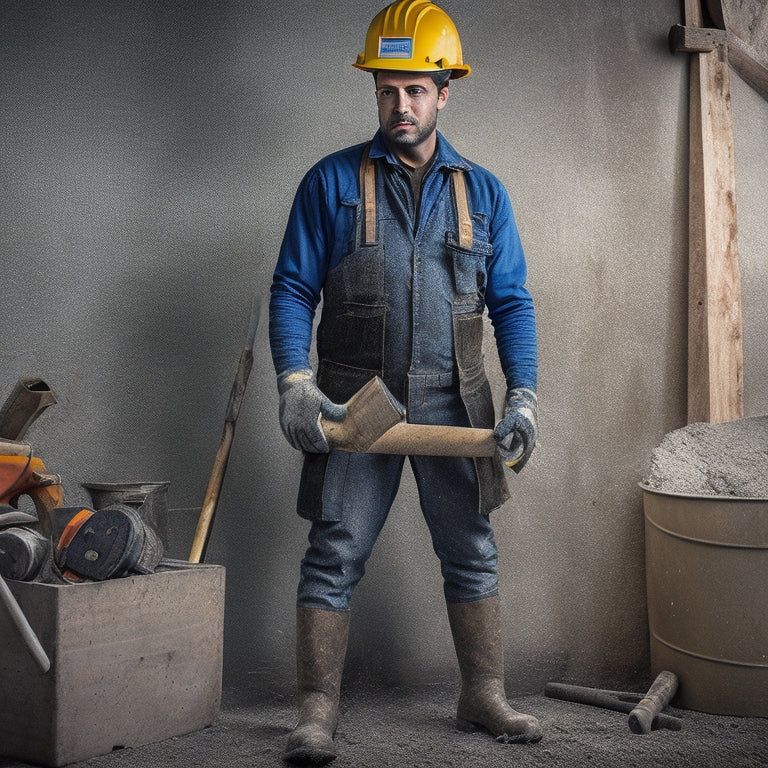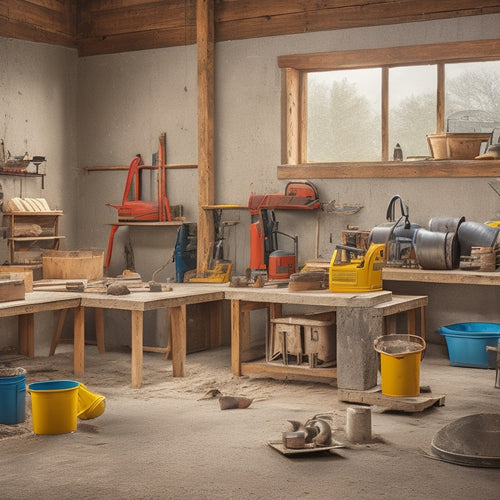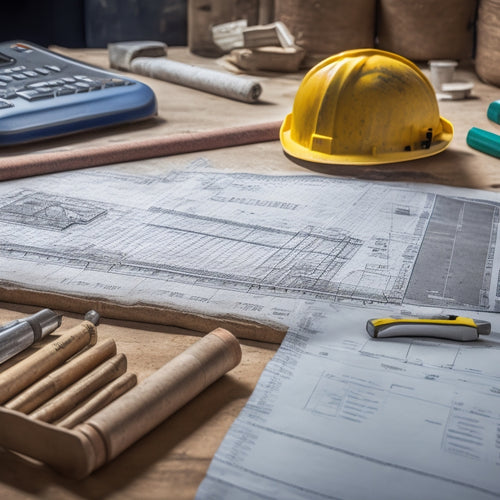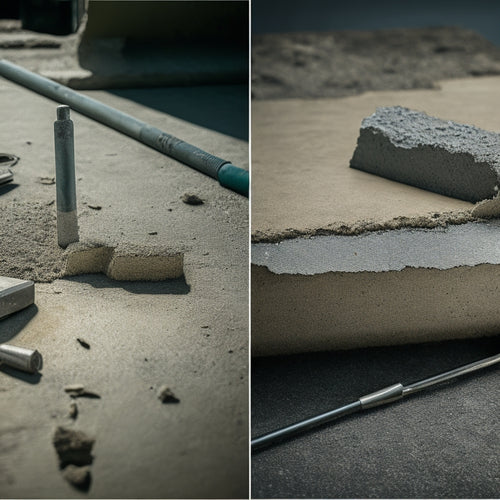
7 Affordable Tools to Level Concrete Walls
Share
You're on the right track to leveling concrete walls without overspending. You'll need a laser level for accuracy, a spirit level for precision, a concrete block plane for smoothing, a concrete grinder for rough surfaces, a hammer and chisel for edges, a self-leveling compound for gaps, and a rotary hammer for heavy-duty tasks. These affordable tools will help you achieve a smooth finish. By incorporating them into your workflow, you'll be able to tackle even the most challenging concrete leveling projects efficiently. Now, discover the specific features and benefits that make each tool an essential part of your concrete leveling arsenal.
Key Takeaways
• A laser level provides high accuracy in concrete wall leveling, identifying deviations from the desired level for prompt adjustments.
• A spirit level is essential for detecting slight deviations in horizontal or vertical planes, ensuring precise results with proper selection and maintenance.
• A concrete grinder is effective for removing coarse aggregate, with the right attachment selection and adequate pass overlap preventing missed spots and unevenness.
• A hammer and chisel are indispensable for breaking away excess material on uneven edges, with mastery of chisel techniques required for effective concrete removal.
• Self-leveling compound is formulated to flow easily and set quickly, filling gaps and depressions in concrete walls for a smooth surface.
Laser Level for Accuracy
When it comes to guaranteeing precision and accuracy in leveling concrete walls, a laser level is a vital tool that allows you to project a perfectly level line or plane onto the surface. This tool provides you with a high degree of accuracy, which is significant in concrete wall leveling.
One of the noteworthy laser level benefits is that it enables you to work efficiently and quickly, saving you time and effort. Additionally, a laser level helps you to identify any deviations from the desired level, allowing you to make necessary adjustments promptly.
Before using a laser level, it's important to perform laser level calibration to verify that it's functioning correctly. Calibration involves checking the level's accuracy and making any necessary adjustments to assure precise results.
Concrete Block Plane for Smoothing
With your laser level calibrated and projecting a perfectly level line, you can now focus on smoothing out any imperfections on the concrete wall surface using a concrete block plane. This tool is designed to remove minor bumps and hollows, ensuring a smooth finish for your concrete wall.
When selecting a concrete block plane, look for one with a sturdy handle and a durable blade that can withstand the rigors of concrete block maintenance.
To use the plane effectively, hold it at a 20- to 30-degree angle and push it forward, applying moderate pressure. This will help you scrape off imperfections and achieve a smooth surface.
As you work, regularly inspect the wall to identify areas that require additional attention. By employing wall smoothing techniques such as this, you'll be able to achieve a professional-looking finish without breaking the bank.
Remember to always work in small sections, as this will allow you to maintain control and precision. With a little practice, you'll be able to use the concrete block plane to achieve a smooth, even finish that will enhance the appearance of your concrete wall.
Spirit Level for Precision
You'll need a spirit level to guarantee accuracy and precision in your concrete wall leveling project, as this tool allows you to detect even the slightest deviations from a true horizontal or vertical plane.
There are several spirit level types to choose from, including bubble levels, laser levels, and digital levels. Bubble levels are the most common and affordable option, while laser levels provide a more accurate reading over longer distances. Digital levels offer high-precision readings and are ideal for complex projects.
Regardless of the type you choose, proper spirit level maintenance is vital to ensure accuracy. Regularly clean the level's glass vial and check for any air bubbles or blockages. Store your spirit level in a protective case when not in use to prevent damage.
It's also essential to calibrate your spirit level periodically to guarantee it remains accurate. By selecting the right spirit level for your project and maintaining it properly, you'll be able to achieve precise results and ensure your concrete walls are perfectly level.
Concrete Grinder for Rough Surfaces
When you're working with rough concrete surfaces, a concrete grinder is an essential tool to have in your arsenal.
You'll need to remove coarse aggregate and create a smooth surface, and that's where the grinder's surface profiling options come in.
Coarse Aggregate Removal
How effectively you remove coarse aggregate from rough concrete surfaces determines the quality of the final finish, and that's where a concrete grinder comes in. This powerful tool is designed to tackle the toughest aggregate separation techniques, guaranteeing a smooth surface for further processing. In order to achieve effective removal methods, you'll need to employ the right techniques and attachments.
Here are the key factors to take into account when using a concrete grinder for coarse aggregate removal:
-
Grinder speed: Adjust the speed to match the aggregate size and surface roughness.
-
Attachment selection: Choose the right grinding disc or drum to effectively remove coarse aggregate.
-
Water application: Use the right amount of water to reduce dust and prevent overheating.
- Pass overlap: Guarantee adequate pass overlap to prevent missed spots and uneven removal.
Surface Profiling Options
Concrete grinders equipped with specialized profiling tools transform rough surfaces into uniform platforms, allowing for precise control over the final surface texture.
As you work on leveling concrete walls, you'll encounter various surface imperfections that require tailored profiling techniques. By selecting the right profiling tool, you can effectively remove high spots, fill low areas, and achieve a smooth, even surface.
When dealing with extremely rough surfaces, you'll want to start with a coarse profiling tool, such as a tungsten carbide cutter or a diamond-segmented wheel. These tools aggressively remove material, rapidly smoothing out the surface.
For finer profiling, switch to a tool with smaller diamonds or a resin-bonded wheel, which will refine the surface texture to your desired level.
Dustless Operation Modes
You can considerably reduce airborne dust and debris by operating your concrete grinder in a dustless mode, especially when tackling rough surfaces with aggressive profiling tools. This is vital when working on concrete walls, as excessive dust can compromise air quality, damage equipment, and hinder visibility.
To achieve a dustless operation, you'll need to integrate dust control measures into your grinding process. Here are some key considerations for a dustless operation:
-
Vacuum attachments: Equip your grinder with a vacuum attachment to capture dust and debris at the source, preventing them from becoming airborne.
-
Dust shrouds: Use dust shrouds to contain dust and direct it towards the vacuum attachment, guaranteeing maximum capture efficiency.
-
Proper ventilation: Maintain good ventilation in the work area to prevent dust from accumulating and circulating.
- Regular maintenance: Regularly clean and maintain your grinder, vacuum, and dust control equipment to secure peak performance and dust capture.
Hammer and Chisel for Edges
When working with uneven edges, a hammer and chisel prove indispensable for breaking away excess material and creating a smooth surface.
You'll need to master chisel techniques to effectively remove concrete and achieve a uniform edge. Start by selecting the right chisel for the job, considering factors like the type of concrete and the desired finish.
Hold the chisel at a 20-degree angle, with the bevel facing the direction you want the concrete to break off. Apply gentle to moderate pressure, depending on the hardness of the concrete, and strike the chisel with your hammer in a controlled motion.
For edge finishing, focus on making precise, shallow cuts to avoid damaging the surrounding concrete. As you work, regularly inspect the edge to ascertain it's even and smooth.
With practice, you'll develop the skills and confidence to tackle even the most challenging edge finishing tasks. By combining the right chisel techniques with a bit of patience, you can achieve professional-looking results without breaking the bank.
Self-Leveling Compound for Gaps
Gaps and depressions in the wall require filling with a self-leveling compound, a specially formulated mixture that flows easily and sets quickly to create a smooth, even surface. This is especially important for self-leveling applications where a strong, stable base is essential. As you prepare to fill the gaps, make sure you've cleaned the area thoroughly and removed any debris or loose material.
Here are some key benefits to take into account when using a self-leveling compound for gap filling:
-
Easy to apply: Self-leveling compounds come in a variety of formulations, including pourable and trowelable options.
-
Fast-setting: Most self-leveling compounds set within 15-30 minutes, depending on the brand and environmental conditions.
-
High-strength: Self-leveling compounds are designed to provide a strong, durable bond with the surrounding concrete.
- Low-shrinkage: These compounds are formulated to minimize shrinkage, ensuring a smooth, even finish.
Rotary Hammer for Heavy-Duty Jobs
For more substantial imperfections in the concrete wall, a rotary hammer becomes the go-to tool, providing the heavy-duty power needed to efficiently break up and remove thick, uneven layers of concrete. You'll appreciate the rotary hammer's features, such as its high-torque motor, durable construction, and adjustable speed control, which enable you to tackle demanding tasks with confidence.
| Rotary Hammer Features | Benefits |
|---|---|
| High-torque motor | Increased power for heavy-duty tasks |
| Durable construction | Long-lasting tool for frequent use |
| Adjustable speed control | Customizable speed for precise control |
To guarantee your rotary hammer remains in top condition, regular maintenance is essential. You should clean the tool regularly, check and replace worn-out parts, and store it in a dry place. Proper maintenance will extend the tool's lifespan and prevent costly repairs. By incorporating a rotary hammer into your toolkit, you'll be well-equipped to tackle even the most demanding concrete leveling tasks. With its impressive power and versatility, this tool is an investment worth considering.
Frequently Asked Questions
Can I Use a Single Tool for Both Rough and Smooth Surfaces?
When tackling surface leveling projects, you're right to wonder if one tool can handle both rough and smooth surfaces.
The answer lies in tool versatility and surface compatibility.
Look for a tool with adjustable settings and interchangeable abrasives to tackle diverse surfaces.
This adaptability guarantees you can effectively level rough concrete and then switch to a finer grit for a smooth finish, all with one reliable tool.
How Do I Choose the Right Tool for My Concrete Wall Type?
When selecting a tool for your concrete wall, you'll want to take into account tool compatibility with the surface type.
Determine if your wall has a rough or smooth finish, as this will impact the tool's effectiveness.
Proper surface preparation is also essential, so assess if your wall requires cleaning, patching, or grinding before leveling.
Are There Any Safety Precautions I Should Take When Leveling?
Oh, you think you're a concrete cowboy, ready to lasso those uneven walls? Not so fast!
Before you start leveling, remember that safety always comes first. You're about to dance with heavy machinery and hazardous materials, so put on your big-boy safety gear, including gloves, goggles, and a dust mask.
Stay alert for trip hazards, electrical risks, and falling debris. Hazard awareness is key to avoiding injuries and costly mistakes.
Can I Level Concrete Walls Without Professional Experience?
You're wondering if you can level concrete walls without professional experience. The answer is yes, but it requires careful planning and execution.
With DIY leveling, you'll need to master concrete wall techniques like evaluating the wall's condition, identifying high and low spots, and applying the right amount of pressure.
It's essential to work methodically, using the right tools and materials, to avoid damaging the wall or compromising its structural integrity.
What Maintenance Is Required for Concrete Leveling Tools?
As you hold the reins of your concrete leveling project, you'll want to keep your tools in top shape to guarantee a smooth ride.
Regular maintenance is key to prolonging tool durability. You'll need to inspect and clean your tools frequently, ideally after each use, to prevent debris buildup and corrosion.
Conclusion
You've got the arsenal to tackle even the most uneven concrete walls.
With these 7 affordable tools, you'll be the master of leveling walls in no time.
From the precision of a spirit level to the brute force of a rotary hammer, you'll be a concrete-whisperer, effortlessly taming the most unruly surfaces.
And when you're done, your walls will be so level, you'll be able to balance a marble on them from a mile away!
Related Posts
-

What Tools to Rent for a Concrete Home Reno
When tackling a concrete home renovation, you'll need to rent a variety of specialized tools to get the job done. For...
-

5 Tips for Accurate Concrete Measurement Tools
To guarantee accurate concrete measurement, you'll want to calibrate your measuring tools regularly, choosing a frequ...
-

Top Tools for Concrete Adhesion Success
When it comes to concrete adhesion success, you'll need to wield the right tools and techniques to guarantee a strong...


